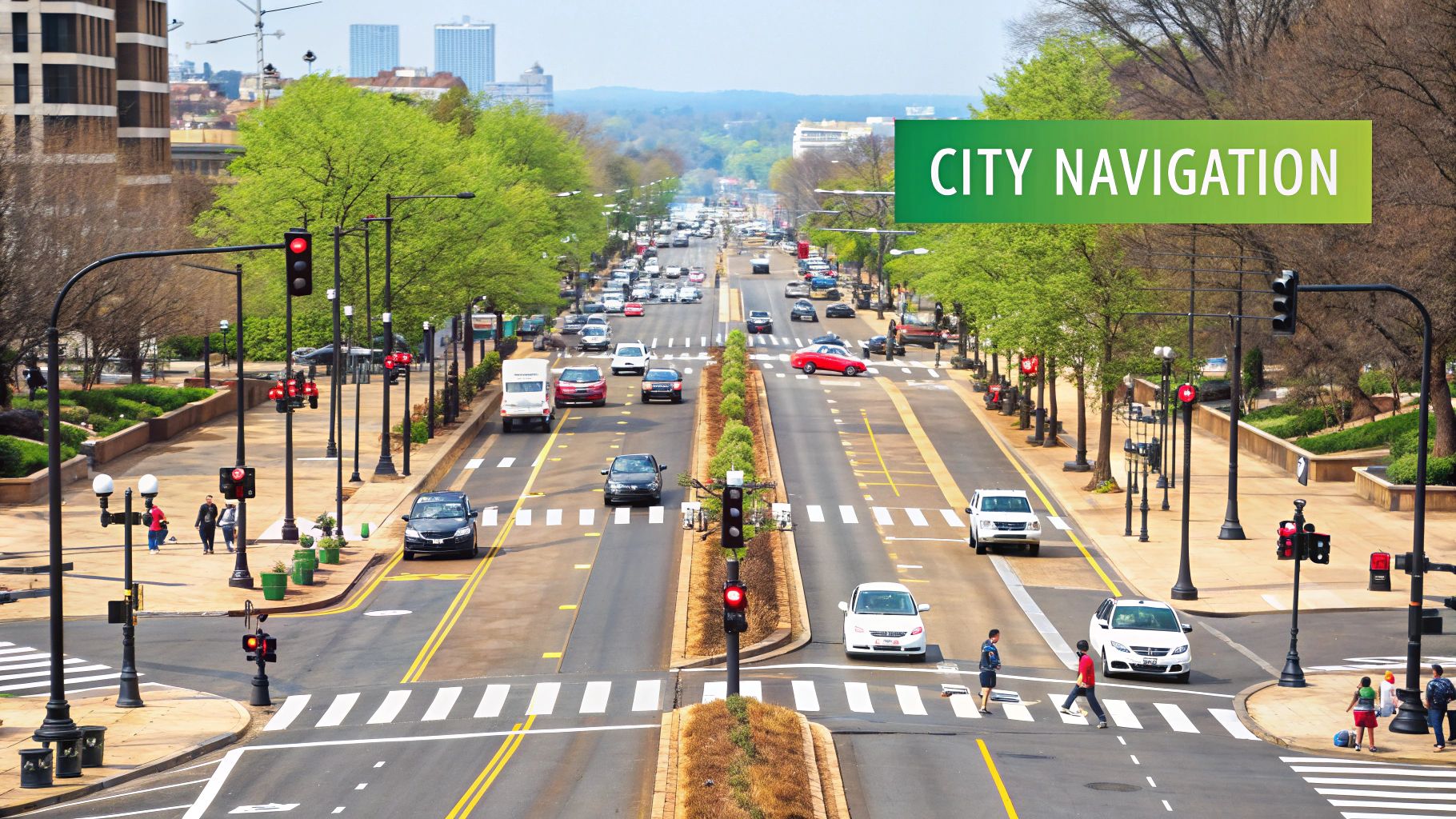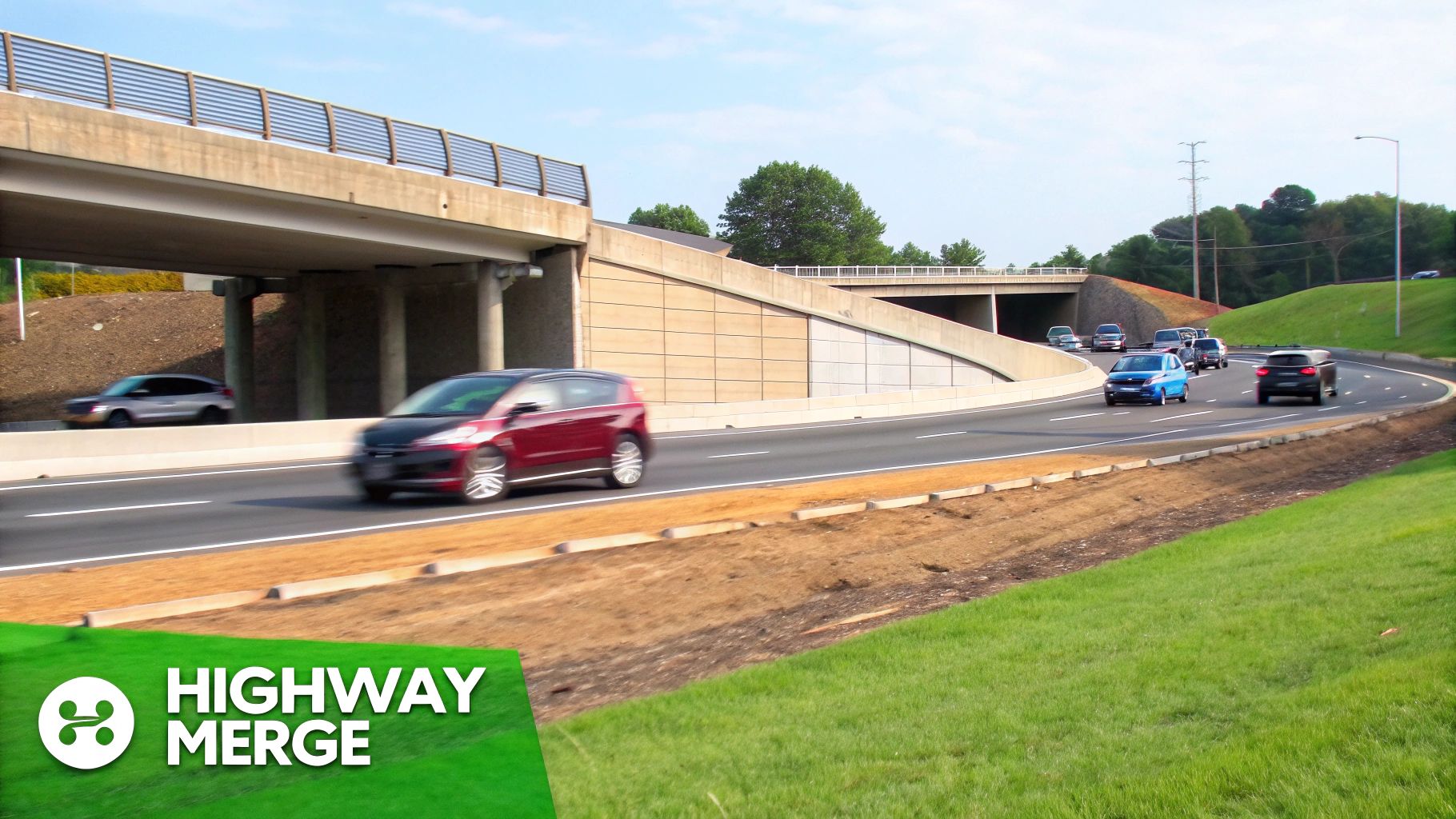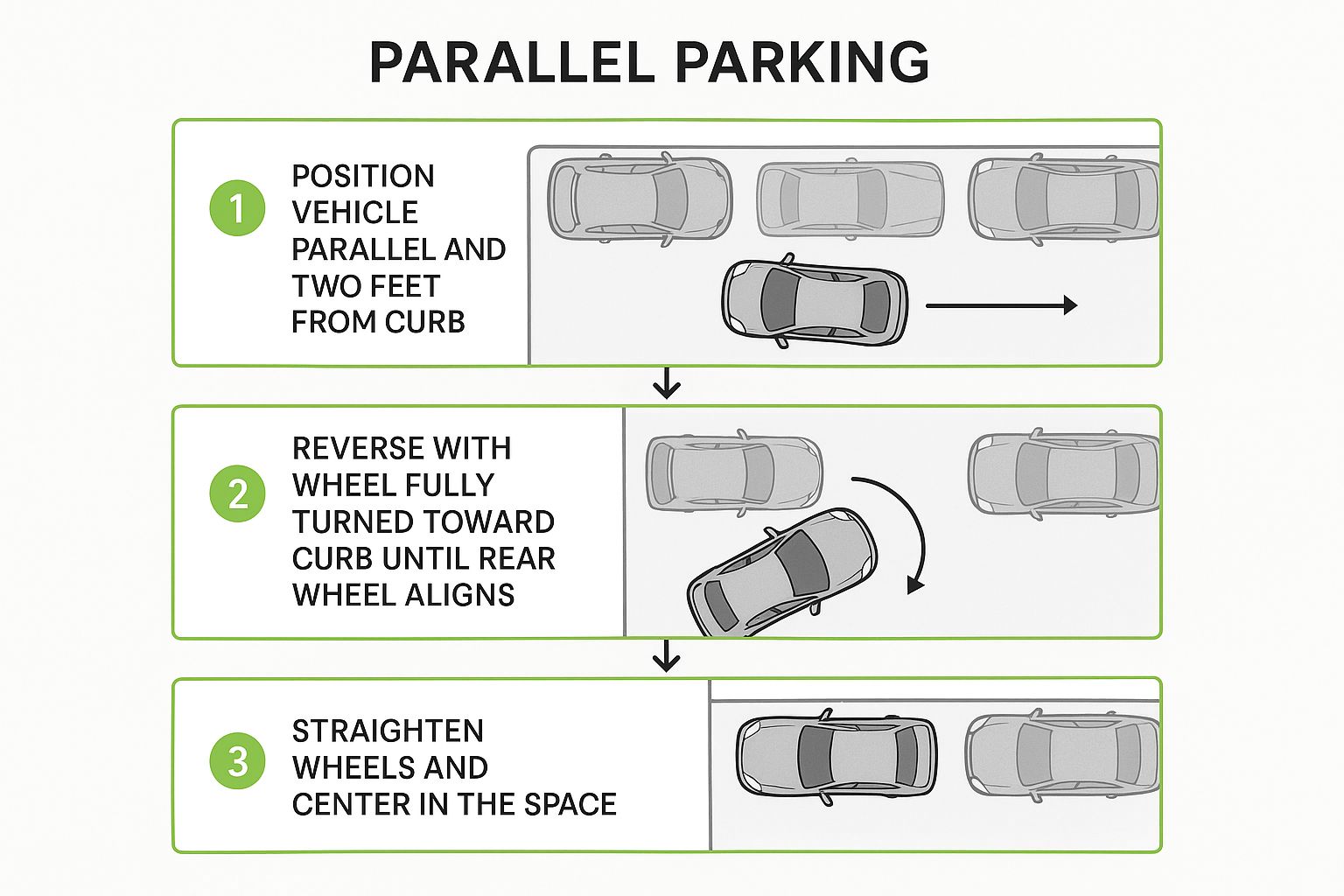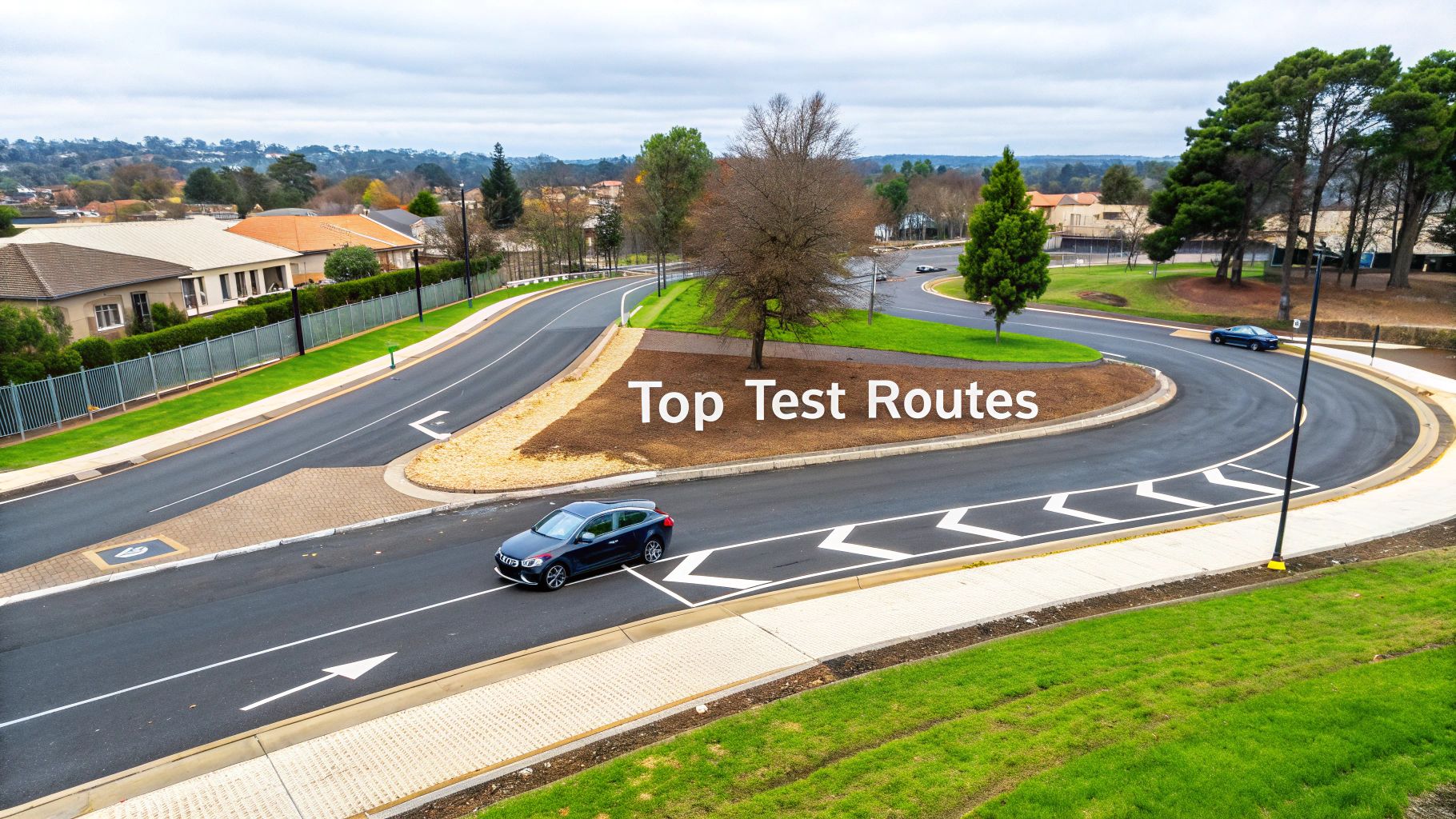Navigate Your Way to Driving Success
Passing your UK driving test requires practice and familiarity with various road types. This listicle covers six common routes for driving test success: urban, highway, residential, roundabout, hill start, and parallel parking. Understanding these routes is crucial for navigating the test confidently and safely. Whether you're a new learner, retaking your test, or looking for intensive courses, this guide provides valuable insights to help you achieve your driving goals. Learn the key features of each route and improve your chances of first-time success.
1. Urban/City Route
The Urban/City route is a common type of driving test route designed to assess a candidate's ability to navigate the complexities of busy urban environments. This route typically includes various challenging elements, such as navigating traffic lights, pedestrian crossings, lane changes, and congested traffic scenarios. It focuses heavily on evaluating spatial awareness, defensive driving techniques, and the candidate’s ability to remain calm and composed under pressure in high-density areas. This route type is crucial for determining a driver's readiness for real-world driving after passing their test, as a significant portion of driving in the UK takes place in urban settings.

The Urban/City route distinguishes itself through several key features: multiple traffic light intersections requiring precise timing and decision-making, pedestrian crossings (often near school zones) demanding extra vigilance, multi-lane roads necessitating appropriate lane selection and execution, one-way streets testing directional awareness, and busy shopping districts with increased pedestrian and vehicle activity. These features combine to create a demanding test of a candidate’s overall driving competence in a realistic urban setting.
Pros:
- Comprehensive Awareness Test: The route thoroughly evaluates awareness of multiple road users, including pedestrians, cyclists, and other vehicles.
- Traffic Signal & Sign Adherence: It effectively tests the candidate's ability to follow traffic signals, road signs, and lane markings accurately.
- Patience and Stress Management: Navigating congested areas assesses the driver’s patience and ability to manage stress in challenging traffic conditions.
Cons:
- Intimidating for Novice Drivers: The busy urban environment can be overwhelming for less experienced drivers, potentially increasing test anxiety.
- Traffic Unpredictability: The inherent unpredictability of city traffic can create inconsistent testing conditions between candidates.
- Favours Urban Practice: Individuals who have practiced extensively in urban areas may have an advantage.
Examples of Urban/City Routes for Driving Tests in the UK:
While specific routes aren't published, areas in larger UK cities with similar characteristics include busy areas around test centres in London, Birmingham, and Manchester. Think of areas with significant traffic flow, complex junctions, and pedestrian activity.
Tips for Navigating Urban/City Routes:
- Mirror Checks: Perform frequent and exaggerated mirror checks to clearly demonstrate your awareness to the examiner.
- Following Distance: Maintain appropriate following distances in stop-and-go traffic to avoid collisions.
- Pedestrian Awareness: Be highly alert for pedestrians stepping into the roadway unexpectedly, particularly near crossings and in shopping districts.
- Emergency Vehicles: Be prepared for emergency vehicles and know how to yield properly and safely.
This route deserves its place on the list of driving test routes because it presents a realistic portrayal of everyday driving challenges in the UK. Mastering this route demonstrates a driver’s preparedness for navigating complex traffic situations and contributes significantly to overall road safety. This is particularly important for learner drivers, those retaking tests, and those seeking intensive training, as it equips them with the crucial skills needed to confidently and safely navigate the demanding urban environment.
2. Highway/Freeway Route
This segment of the driving test focuses on your ability to navigate highways and freeways safely and confidently. It's a crucial part of many driving tests, including those in the UK, as it assesses essential skills needed for everyday driving on motorways like the M1 or M25. This route typically involves merging onto the freeway via acceleration lanes, maintaining appropriate speeds (generally between 55-70 mph or 90-110 kph), executing lane changes at speed, keeping a safe following distance, and navigating exit ramps. This section of the test evaluates not just your technical driving skills but also your decision-making and ability to handle the pressures of higher-speed driving.

The highway/freeway portion of the driving test is essential because motorways form a significant part of the UK road network. Successfully completing this section demonstrates your competence in handling these higher-speed roads and your ability to integrate safely with faster-moving traffic flow. This section is particularly important for beginner learners, those retaking their tests, and those seeking advanced driving qualifications. Features like acceleration lanes, high-speed driving zones, and the need for lane changes at speed offer a realistic environment for the examiner to assess your skills.
Pros:
- Tests Crucial Highway Safety Skills: This section evaluates essential skills necessary for safe motorway driving, which is vital for all drivers in the UK.
- Evaluates Confidence at Higher Speeds: It assesses your composure and ability to make safe decisions under the pressure of higher speeds.
- Assesses Road Sign Comprehension: Navigating freeways requires quickly understanding and reacting to road signs while maintaining focus on the traffic around you, a skill directly tested in this portion.
Cons:
- May Increase Anxiety: For new drivers, the prospect of driving at higher speeds can be intimidating.
- Weather Dependency: Adverse weather conditions can significantly increase the difficulty of this section.
- Geographic Limitations: Not all testing centers have easy access to freeways, potentially limiting its inclusion in some tests.
Tips for Success on the Highway/Freeway Section:
- Early Signaling: Signal your intentions to merge or change lanes well in advance (at least 3-5 seconds). This gives other drivers ample time to react.
- Appropriate Acceleration: Use the acceleration lane effectively to match the speed of the highway traffic before merging.
- Maintain Safe Following Distance: Adhere to the 3-second rule, especially at higher speeds, to allow for adequate reaction time.
- Thorough Blind Spot Checks: Always check your blind spots meticulously before initiating any lane change.
- Plan Your Exits: Start preparing for your exit well in advance. This includes moving into the correct lane early and reducing your speed smoothly as you approach the exit ramp.
This part of the driving test deserves its place in the list of routes because it directly correlates with real-world driving scenarios on UK motorways. It's a practical assessment of the essential skills required for safe and confident driving on high-speed roads. Whether you are a beginner learner, retaking your test, or pursuing advanced qualifications, mastering this section is paramount for safe and successful driving in the UK. The combination of practical skills, decision-making under pressure, and adherence to traffic laws makes this a crucial component of any comprehensive driving test.
3. Residential Route
The Residential Route is a common feature of driving tests, designed to assess your ability to navigate quieter streets safely and responsibly. This part of the routes for driving test focuses on low-speed maneuvers, observation skills, and adherence to traffic regulations in areas with potential hazards like children playing or parked cars. It's a crucial component because it evaluates your vigilance and control in seemingly "easier" environments, skills essential for safe everyday driving.
This type of route typically involves navigating streets with speed limits between 20-30 mph (30-50 kph). You'll encounter numerous stop signs and yield situations, often on narrow streets lined with parked vehicles on both sides. The presence of school zones, playgrounds, and potential unmarked intersections further emphasizes the need for constant observation and anticipation. Residential areas in Birmingham or Manchester, and indeed quieter neighbourhoods near DMV locations across the UK, exemplify the kind of environment you might encounter on this section of your test.
Why is this route included in the driving test?
The Residential Route tests skills vital for safe driving, even if it initially seems less challenging than busier roads. It specifically evaluates your ability to:
- Maintain vigilance: Can you stay alert and focused even in a less stimulating environment?
- Perform complete stops: Do you fully stop at stop signs, allowing the car to settle before proceeding?
- Demonstrate spatial awareness: Can you navigate narrow streets with parked cars, judging clearances and maintaining safe passing distances?
Pros:
- Tests essential observation skills in everyday driving scenarios.
- Evaluates precise control at low speeds and adherence to stop signs.
- Assesses spatial awareness in confined spaces.
Cons:
- Can be deceptively challenging, requiring constant vigilance.
- Variations in residential layouts between test centres can make preparation unpredictable.
- Offers limited opportunities to showcase higher-speed driving skills.
Tips for Navigating the Residential Route:
- Come to a complete stop at stop signs: Ensure your car comes to a standstill and feels settled before proceeding. This demonstrates proper control and respect for traffic regulations.
- Scan constantly: Be vigilant for children, pets, or any unexpected objects that might enter the street. Regularly check your mirrors and blind spots.
- Maintain appropriate speed: Driving 5-10 mph below the posted speed limit is often advisable in residential areas, allowing more time to react to potential hazards.
- Exercise caution around parked cars: Be prepared for occupants to suddenly open doors or pull out into the roadway. Maintain a safe passing distance.
- Practice proper spacing: When passing parked vehicles, ensure adequate space to avoid collisions and allow oncoming traffic to pass safely.
For learner drivers in the UK, mastering the Residential Route is essential for passing the practical driving test and developing safe driving habits for life. Whether you are a beginner learner, retaking your test, or seeking specialized tuition, practicing in similar environments will significantly improve your performance and confidence on this crucial element of the routes for driving test. While intensive courses and discounted options may focus on various routes, dedicating time to residential practice is an invaluable investment in your driving future.
4. Roundabout/Traffic Circle Route
Navigating roundabouts efficiently and safely is a crucial skill assessed on UK driving tests. This route type, often a core component of routes for driving test, focuses on multi-lane and single-lane roundabouts, evaluating a driver's ability to apply roundabout rules, choose correct lanes, signal appropriately, and yield to traffic already on the roundabout. This section will help you understand why roundabouts are such a critical aspect of driving tests and how to master them.

This route type deserves its place on the list due to the complex decision-making and control it demands. It's not just about steering; it's about observing, predicting, and reacting to the flow of traffic within a dynamic environment. Features tested within this route include proper entry yielding requirements, lane selection before and within the roundabout, correct signaling protocols when exiting, and navigating a series of consecutive roundabouts. This assesses smooth handling, appropriate speed adjustment, and adherence to signaling discipline.
Successful negotiation of complex roundabouts, such as the Swindon 'Magic Roundabout,' is a testament to a learner's grasp of roundabout principles. Areas like Carmel, Indiana (though not in the UK, it exemplifies roundabout prevalence), and Milton Keynes are known for their extensive use of roundabouts, making them valuable learning grounds and frequent features in driving test routes.
Pros:
- Tests comprehension of roundabout rules, an area many learners find challenging.
- Evaluates smooth vehicle control and appropriate speed adjustment.
- Assesses proper signaling habits, crucial for safe roundabout navigation.
Cons:
- While common in UK tests, regional variations in roundabout design can sometimes present unfamiliar scenarios.
- Learners from areas with fewer roundabouts may require additional practice.
Tips for Mastering Roundabouts:
- Yield: Always give way to traffic already circulating within the roundabout.
- Signal Right: Indicate your intention to exit the roundabout by signaling right as you approach your exit.
- Lane Selection: Choose the appropriate lane before entering the roundabout based on your intended exit point. Left lane for left turns or going straight, right lane for right turns or going full circle. Be aware of lane markings and follow directions.
- Steady Speed: Maintain a slow, steady speed while navigating the roundabout.
- Observation: Continuously check your mirrors and blind spots throughout the maneuver.
Roundabout competence is essential for safe and efficient driving in the UK. This route type, popularized by the UK Driving Standards Agency and commonly used in Australian and New Zealand testing protocols, ensures learners are well-prepared for real-world driving scenarios. Mastering roundabouts not only increases your chances of passing the driving test but also equips you with vital skills for navigating roads throughout the UK.
5. Hill Start/Slope Route
This crucial segment of the driving test, often referred to as the hill start or slope route, assesses your ability to safely control your vehicle on inclines and declines. It's a vital part of the test as it evaluates a fundamental driving skill necessary for navigating the diverse road conditions found across the UK, from the rolling hills of the Cotswolds to the steeper streets of Sheffield and Bristol. This part of the test demonstrates your understanding of how gravity affects your car and your proficiency in preventing rollback or uncontrolled forward movement. While particularly important for manual transmission drivers, hill starts and general slope control are also assessed for those taking their test in an automatic vehicle. Therefore, understanding this aspect of the routes for driving test is essential for all learner drivers.
The hill start/slope route tests several specific skills:
- Uphill Starts: For manual drivers, this requires precise clutch control, finding the "bite point," and smoothly coordinating clutch release with accelerator and handbrake. Automatic drivers are assessed on their ability to transition smoothly from brake to accelerator without rollback.
- Parking on Hills: This assesses your knowledge of correct wheel positioning to prevent the car from rolling into traffic should the brakes fail. This involves turning the wheels towards the kerb when parked downhill and away from the kerb when parked uphill.
- Downhill Control: Maintaining a safe speed and using appropriate braking techniques are essential on declines. This also involves using engine braking in manual cars and understanding how to use lower gears for greater control.
- Emergency Brake Usage: In certain situations, the examiner may assess your ability to use the handbrake (or parking brake in automatics) safely and effectively on an incline, usually as a last resort to prevent rollback in a controlled manner.
Why This Matters for UK Drivers: Mastering hill starts and slope control is especially relevant in the UK, where hilly terrain is common in many areas. Imagine navigating the steep inclines of Sheffield or Bristol without confidence in your hill start technique! This section of the driving test ensures you possess the skills to handle such situations safely and competently.
Pros:
- Tests a crucial safety skill essential for driving in hilly regions.
- Evaluates fine motor control and coordination, especially in manual transmission vehicles.
- Assesses understanding of vehicle physics and control.
Cons:
- Can be anxiety-inducing for many test-takers due to the perceived pressure of executing a perfect hill start.
- Can be disproportionately challenging for manual transmission drivers due to the complexity of clutch and handbrake coordination.
- Difficulty varies based on the steepness of available hills in the specific test area. Some test centres may have steeper hills than others, adding an element of unpredictability.
Examples of Hill Routes in the UK:
- Sheffield is well known for incorporating challenging hill starts into its driving test routes.
- Bristol also features significant inclines that often form part of the driving test.
- While less dramatically hilly than Sheffield or Bristol, even relatively flat areas will include slight inclines to test basic slope control.
Tips for Success:
- Manual Transmission: Practice finding the "bite point" of the clutch. This is the point where the engine begins to engage the wheels. Become comfortable holding the car steady on an incline using just the clutch and accelerator before releasing the handbrake.
- Automatic Transmission: Focus on a smooth transition from brake to accelerator. Some newer automatics have hill-hold assist features, but you should still practice controlling the car on a slope without relying solely on these aids.
- Parking on Hills: Memorize the rules for wheel positioning: towards the kerb when facing downhill, away from the kerb when facing uphill.
- Downhill Driving: Maintain extra following distance to allow ample time to react to hazards. Check your mirrors before starting downhill to be aware of vehicles behind you.
This segment of the routes for driving test deserves its place due to the importance of safe hill starts and slope control for all drivers, particularly in a region like the UK with its varied terrain. Mastering this skill will not only help you pass your test but also equip you with the essential skills for safe and confident driving on the UK's roads.
6. Parallel Parking Route
The parallel parking route is a crucial element of the UK driving test, designed to assess your ability to safely and efficiently park between two vehicles or within a designated bay. This manoeuvre tests several key skills including spatial awareness, precise vehicle control, and the ability to execute a multi-step process. It's an essential skill for navigating real-world parking situations, especially in urban environments like London or Birmingham, and therefore holds a significant place in the "routes for driving test" curriculum.

The infographic illustrates the process of parallel parking, breaking it down into key steps: positioning the car alongside the front vehicle, initiating the reverse turn, straightening the wheel as the rear aligns with the rear vehicle's bumper, and making final adjustments. The sequential nature of these steps emphasizes the importance of precision and timing in executing a successful parallel park.
This section of the driving test demands proficiency in judging distances from the curb and other vehicles, executing multi-point maneuvers, utilizing mirrors and over-the-shoulder checks, and making necessary adjustments to your position. Mastering this skill demonstrates fine control at low speeds and a solid understanding of your vehicle's dimensions. While often the most dreaded part of the test, it is a practical skill applicable to everyday driving situations across the UK.
Pros:
- Tests a crucial everyday parking skill.
- Evaluates spatial perception and awareness of vehicle dimensions.
- Demonstrates fine control at low speeds.
Cons:
- Often considered the most challenging aspect of the driving test.
- Difficulty can vary depending on the size of the parking space and the dimensions of the vehicle.
- Assisted parking features, common in newer vehicles, are not permitted during the test.
Examples:
Parallel parking is an essential skill tested in driving tests across the UK, mirroring the requirements of urban driving in major cities. This manoeuvre is also a standard part of driving tests in many other countries, including parts of Europe and the USA.
Tips for Successful Parallel Parking:
- Position your vehicle parallel to the car in front of the desired space, maintaining a distance of approximately 2-3 feet.
- Turn the steering wheel fully towards the curb as you begin reversing.
- Start straightening the steering wheel when your rear wheel is roughly aligned with the front bumper of the car behind you.
- Make small, controlled adjustments rather than rushing the manoeuvre.
- Regularly check all mirrors and blind spots before changing direction.
The video above provides a visual demonstration of the parallel parking procedure, offering valuable guidance for learners. Practicing this manoeuvre repeatedly is essential for building confidence and proficiency, which will be invaluable during your driving test. This segment features prominently in driving courses around the world and is often portrayed in popular culture as the ultimate test of driving skill. Its inclusion in the "routes for driving test" list is undeniable, given its direct relevance to real-world driving and its importance in assessing a candidate's overall driving competence.
Driving Test Routes Comparison
| Route Type | Implementation Complexity 🔄 | Resource Requirements ⚡ | Expected Outcomes 📊 | Ideal Use Cases 💡 | Key Advantages ⭐ |
|---|---|---|---|---|---|
| Urban/City Route | High due to complex traffic scenarios | Moderate, requires real traffic | Tests spatial awareness, defensive driving, stress management | Suitable for assessing urban driving skills | Comprehensive multi-user awareness; traffic signal proficiency |
| Highway/Freeway Route | Moderate to high due to speed & merging | Moderate, needs highway access | Evaluates high-speed control, safe merging, lane changes | Best for highway driving confidence testing | Tests crucial highway safety; high-speed maneuvering skills |
| Residential Route | Low to moderate; slower speeds, simpler | Low; quiet neighborhoods suffice | Assesses vigilance in low-speed, hazard-prone areas | Ideal for urban outskirts or suburban testing | Emphasizes caution, stop compliance, narrow-road awareness |
| Roundabout/Traffic Circle Route | Moderate complexity; lane choice & signaling | Moderate, requires roundabouts | Measures understanding of roundabout rules, smooth handling | Effective where roundabouts are common | Tests yielding, lane discipline, signaling discipline |
| Hill Start/Slope Route | Moderate; requires fine motor skills | Location-dependent; needs hills | Tests vehicle control on inclines, coordination | Essential in hilly or mountainous regions | Critical for hill driving safety and coordination |
| Parallel Parking Route | Moderate; requires precision maneuvers | Low; simulated or real parking spaces | Evaluates spatial awareness, multi-step parking ability | Useful in urban areas with tight parking spots | Practical everyday parking skill; fine low-speed control |
Ready to Take the Wheel?
Knowing the potential routes for driving test is crucial for building confidence and skill behind the wheel. This article has outlined key route types you're likely to encounter during your UK driving test, including urban/city routes, highway/freeway routes, residential areas, roundabouts, hill starts, and parallel parking situations. Mastering these diverse driving scenarios will not only increase your chances of test success but also prepare you for the realities of everyday driving.
By understanding the specific challenges each route presents – from navigating complex junctions in city centres to safely merging onto motorways – you can focus your practice and quickly improve your weaknesses. This targeted approach is invaluable for both new learners and those retaking their tests. Remember, consistent practice on these routes is key to becoming a safe and confident driver. Once you've passed your driving test and are ready to hit the road, remember that car insurance is a must. Learning how to reduce insurance premiums can help you save money while staying protected.
Take control of your driving journey with Fast Pass Driving Courses. We offer specialized instruction and flexible scheduling tailored to help you master these essential routes for driving test success. Book your course today and fast-track your path to becoming a confident, licensed driver!

